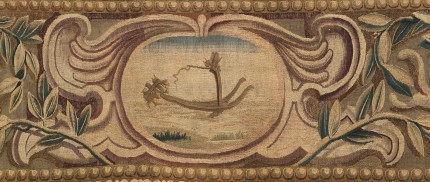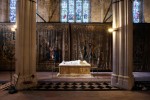 The Life of Christ tapestries have made their triumphant return to public view for the first time since a 2001 fire almost reduced these precious 17th century masterpieces to cinders. As of March 21st, they are hanging in the Cathedral Church of St. John the Divine in Manhattan. It has taken a decade and a half of painstaking labor from conservators for this day to arrive.
The Life of Christ tapestries have made their triumphant return to public view for the first time since a 2001 fire almost reduced these precious 17th century masterpieces to cinders. As of March 21st, they are hanging in the Cathedral Church of St. John the Divine in Manhattan. It has taken a decade and a half of painstaking labor from conservators for this day to arrive.
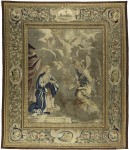 The story begins with a pope who had a great love of luxury textiles and an even greater love of nepotism. Maffeo Barberini was elected to the Throne of St. Peter as Pope Urban VIII in 1623 and wasted no time in spreading the ecclesiastical wealth around to his family members. He made his brother Antonio a cardinal. He made his brother Carlo’s sons Francesco and Antonio cardinals too. Other family members got grand titles (Duke, Prince), extensive properties in the Papal States, cushy sinecures and military commands requiring little in the way of actual soldiering.
The story begins with a pope who had a great love of luxury textiles and an even greater love of nepotism. Maffeo Barberini was elected to the Throne of St. Peter as Pope Urban VIII in 1623 and wasted no time in spreading the ecclesiastical wealth around to his family members. He made his brother Antonio a cardinal. He made his brother Carlo’s sons Francesco and Antonio cardinals too. Other family members got grand titles (Duke, Prince), extensive properties in the Papal States, cushy sinecures and military commands requiring little in the way of actual soldiering.
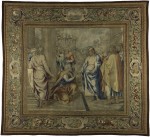 Rome was not known for its tapestry industry — France and Flanders dominated tapestry production in Europe — but for a brief window in the 17th century, it came to prominence thanks entirely to Cardinal Francesco Barberini, Urban’s nephew. He founded a private tapestry workshop in 1627, hand-picked its staff and oversaw the production of six multi-tapestry series depicting the early history of Christianity and the Church.
Rome was not known for its tapestry industry — France and Flanders dominated tapestry production in Europe — but for a brief window in the 17th century, it came to prominence thanks entirely to Cardinal Francesco Barberini, Urban’s nephew. He founded a private tapestry workshop in 1627, hand-picked its staff and oversaw the production of six multi-tapestry series depicting the early history of Christianity and the Church.
His papal uncle shared Francesco’s love for tapestries, the more silk, gold and silver thread the better. He already had a large collection before he was elected pope. After the dramatic improvement in family status, Francesco’s workshop gave the Barberini the opportunity to create personalized tapestries by the greatest artists in the richest materials, the kind of access only royalty (and in Italy, the Medici family of Florence) had.
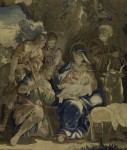 The Life of Christ cycle, designed by Giovanni Francesco Romanelli and woven by Gaspare Rocci, Caterina della Riviera and Maria Maddalena della Riviera, monopolized the workshop from 1643 to 1656. There were some gaps in there due to unforseen obstacles. Urban VIII died in 1644, severely hampering the production schedule. The new pope was no Barberini fan, and Francesco was soon tied up with investigations of his alleged misappropriation of funds. Production cranked back into gear in 1647, but it still took another nine years to complete the series.
The Life of Christ cycle, designed by Giovanni Francesco Romanelli and woven by Gaspare Rocci, Caterina della Riviera and Maria Maddalena della Riviera, monopolized the workshop from 1643 to 1656. There were some gaps in there due to unforseen obstacles. Urban VIII died in 1644, severely hampering the production schedule. The new pope was no Barberini fan, and Francesco was soon tied up with investigations of his alleged misappropriation of funds. Production cranked back into gear in 1647, but it still took another nine years to complete the series.
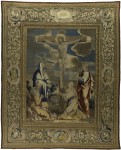 The workshop died with Francesco, its driving impetus, in 1679, and that was the end of Rome’s brief moment of relevance in the history of Baroque tapestry. The Life of Christ cycle hung on the walls of the Barberini family palaces until it was purchased along with the rest of the Barberini tapestry collection (135 in total) by wool manufacturer and tapestry expert Charles Mather Ffoulke in 1889. He moved them to the States where he resold the Life of Christ tapestries to Mrs. Elizabeth U. Coles. A devout congregant, Coles donated the complete series to the Cathedral of Saint John the Divine in 1891, before the church was built.
The workshop died with Francesco, its driving impetus, in 1679, and that was the end of Rome’s brief moment of relevance in the history of Baroque tapestry. The Life of Christ cycle hung on the walls of the Barberini family palaces until it was purchased along with the rest of the Barberini tapestry collection (135 in total) by wool manufacturer and tapestry expert Charles Mather Ffoulke in 1889. He moved them to the States where he resold the Life of Christ tapestries to Mrs. Elizabeth U. Coles. A devout congregant, Coles donated the complete series to the Cathedral of Saint John the Divine in 1891, before the church was built.
 The Barberini tapestries were added to by other donors, until by the mid-20th century, Saint John the Divine found itself the proud owner of Flemish tapestries depicting the Acts of the Apostles made from Raphael cartoons and nine Mortlake tapestries. With such an important and unique collection, the Cathedral opened an in-house Textile Conservation Laboratory in 1981.
The Barberini tapestries were added to by other donors, until by the mid-20th century, Saint John the Divine found itself the proud owner of Flemish tapestries depicting the Acts of the Apostles made from Raphael cartoons and nine Mortlake tapestries. With such an important and unique collection, the Cathedral opened an in-house Textile Conservation Laboratory in 1981.
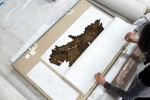 That expertise proved invaluable when tragedy struck in December 2001. A five-alarm fire broke out in the sanctuary, and the six Barberini tapestries hanging on the other side of the wall in the nave (the other six were already in the conservation lab when the fire started, thankfully) took heavy smoke and fire damage. Two of them, The Last Supper and The Resurrection, were so damaged that 30 to 40% of them were destroyed.
That expertise proved invaluable when tragedy struck in December 2001. A five-alarm fire broke out in the sanctuary, and the six Barberini tapestries hanging on the other side of the wall in the nave (the other six were already in the conservation lab when the fire started, thankfully) took heavy smoke and fire damage. Two of them, The Last Supper and The Resurrection, were so damaged that 30 to 40% of them were destroyed.
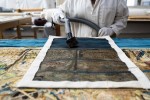 The conservation lab has been working on the delicate tapestries ever since. It’s a time-consuming, incredibly detailed job to clean and repair tapestries 16 feet tall and 12-19 feet wide one inch at a time. It has taken 16 years, but now 10 of the 12 tapestries of Life of the Christ have returned to the Cathedral of Saint John the Divine. The two heavily damaged ones have been stabilized, but are in no condition to be hung.
The conservation lab has been working on the delicate tapestries ever since. It’s a time-consuming, incredibly detailed job to clean and repair tapestries 16 feet tall and 12-19 feet wide one inch at a time. It has taken 16 years, but now 10 of the 12 tapestries of Life of the Christ have returned to the Cathedral of Saint John the Divine. The two heavily damaged ones have been stabilized, but are in no condition to be hung.
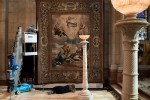 Instead of being installed way up high above the transepts as they were before the fire, they are now hanging in three chapels at eye level.
Instead of being installed way up high above the transepts as they were before the fire, they are now hanging in three chapels at eye level.
The Rev. Canon Patrick Malloy, the priest who oversees arts-related projects at the cathedral, in the Morningside Heights neighborhood of Manhattan, said the idea was to recreate a Baroque chapel and show the tapestries differently from when they hung over the transepts. But he said the exhibition was more than just that.
“They’re hanging in a liturgical space,” Dr. Malloy said, “so they’re not just works of art but devotional objects. It wouldn’t be the same if they were in the Met. I go to the Cloisters from time to time. It’s wonderful, but it’s not the same as if it were a monastery.”
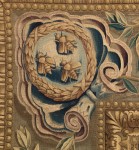 The new installation will give visitors the chance to examine the tapestries in much more detail. Tangential to the religious theme of the tapestries but very much central to the monarchical power they were meant to telegraph, the three bees on the Barberini family coat of arms are plastered in the four corners of each tapestry.
The new installation will give visitors the chance to examine the tapestries in much more detail. Tangential to the religious theme of the tapestries but very much central to the monarchical power they were meant to telegraph, the three bees on the Barberini family coat of arms are plastered in the four corners of each tapestry.
The Barberini bees are a common sight in Rome. After the elevation of Urban VIII to the papacy, he slapped those bees on everything from Barberini properties, to the bronze baldachin in St. Peter’s made of ancient Roman beams stolen from the Pantheon and melted down, to frescoes in the Vatican made a dozen years before Maffeo was even ordained a priest.
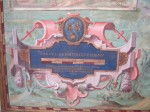 Of course they were woven into the tapestries, just as the kings of France wove their fleurs-de-lis on the tapestries they commissioned. The ones in the corners are the traditional three bees, two on top, one on the bottom, encircled by a laurel wreath in place of the shield, but the bees also appear on the tapestries in a rather bizarre tableau that I’ve never seen before, notwithstanding the Barberini penchant for scattering their pollinators far and wide in the city of Rome. There are three bees, yes, but two of them are pulling a plough while one rides above them holding a whip. This curious arrangement is apparently a very, very arcane reference to Virgil’s Georgics, and symbolizes the powerful combination of “highest rule, sown fields of cultivated land, production of honey.” It may be a nod to Urban’s three nephews — Francesco, Antonio and Taddeo — who held the three highest offices (not counting the pope, of course) of the Roman Church and whose combined labors were meant to ensure the continued wealth and victory of the Church.
Of course they were woven into the tapestries, just as the kings of France wove their fleurs-de-lis on the tapestries they commissioned. The ones in the corners are the traditional three bees, two on top, one on the bottom, encircled by a laurel wreath in place of the shield, but the bees also appear on the tapestries in a rather bizarre tableau that I’ve never seen before, notwithstanding the Barberini penchant for scattering their pollinators far and wide in the city of Rome. There are three bees, yes, but two of them are pulling a plough while one rides above them holding a whip. This curious arrangement is apparently a very, very arcane reference to Virgil’s Georgics, and symbolizes the powerful combination of “highest rule, sown fields of cultivated land, production of honey.” It may be a nod to Urban’s three nephews — Francesco, Antonio and Taddeo — who held the three highest offices (not counting the pope, of course) of the Roman Church and whose combined labors were meant to ensure the continued wealth and victory of the Church.
I don’t know if any of that makes much sense, but I’m kind of crazy about the image of the Barberini bees pushing that plough with their tiny bee hands while their brother/overseer cracks the whip.
